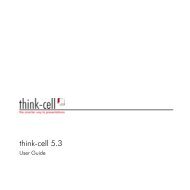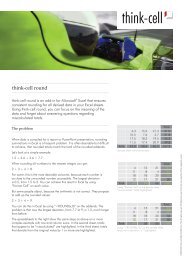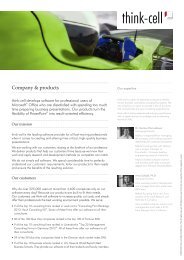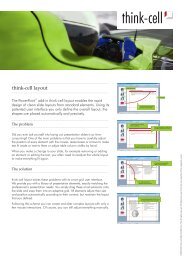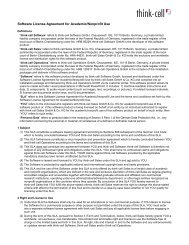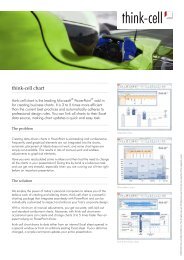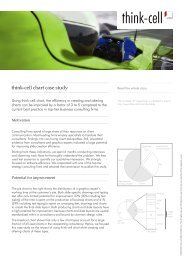think-cell technical report TC2003/01 A GUI-based Interaction ...
think-cell technical report TC2003/01 A GUI-based Interaction ...
think-cell technical report TC2003/01 A GUI-based Interaction ...
You also want an ePaper? Increase the reach of your titles
YUMPU automatically turns print PDFs into web optimized ePapers that Google loves.
7 Conclusion<br />
CONCLUSION<br />
In this chapter I present an outlook of future work that is required or desirable to<br />
further pursue the goal of highly efficient slide layout. Finally, a résumé summarizes<br />
the lessons learned from my thesis.<br />
7.1 Future Work<br />
During the work on the interaction concept and the user interface prototype, a lot<br />
of ideas arose that would be worth further investigation. These ideas, which are<br />
briefly discussed in this section, could not be realized in the scope of the present<br />
thesis. However, the results from my thesis became part of a PowerPoint add-in<br />
for automated layout support, which will continue to be developed and finally will<br />
be commercially deployed. Therefore, it is not unlikely that some of the following<br />
ideas will contribute to future releases of the software.<br />
Constraints Spanning Multiple Slides. So far, the smart grid concept rep-<br />
resents constraints that relate smart elements within a single slide. It is not yet<br />
possible to create constraints between elements from different slides. In practice,<br />
there is mainly one kind of constraint that spans across multiple slides: Certain<br />
elements like headlines and stickers need to be placed in the same location on every<br />
slide where they occur. As suggested in section 4.1.2, across-slide constraints could<br />
be implemented in a straight-forward manner by global smart gridlines that are<br />
placed at the same position on each slide.<br />
Styles and Formatting. Although formatting options like fonts and colors are<br />
not directly related to spatial constraints, these features play an important role in<br />
professional slide design. In particular, consistent formatting of all elements across<br />
all slides or even across a set of presentations must be enforced. Style templates as<br />
they are known from standard office software address this issue, but exhibit serious<br />
usability problems. It would be interesting to see if the concept of constraints could<br />
also be applied to styles and formatting, and if it could help to efficiently create<br />
consistent designs.<br />
Animated Feedback. As suggested in section 4.2.6, animation could be very<br />
effective to explain dynamic layout updates. Further studies with the software will<br />
show if users understand what happens to the slide layout when the automation<br />
takes over. I would expect that users might get confused when the self-adjusting<br />
layout suddenly changes the appearance of a slide. Gleicher et al. [Gle92] found<br />
that an animated transition between two states of the layout can help to explain<br />
the effects of constraints and thus can improve the usability of an automated layout<br />
tool.<br />
88



